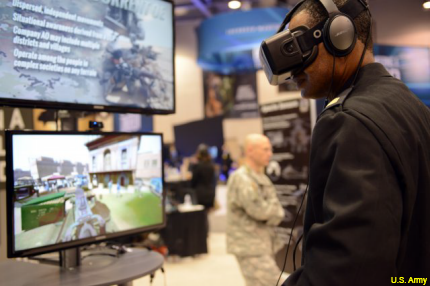Army outlines plans for the next-generation of virtual training
The tools, designed to address the changing nature of combat, will reside on a global, cloud-based network that will connect solders around the world.

A solider tries out a Virtual Battle Space scenario at a recent symposium in Hunstville, Ala.
While Army training will always need to involve a physical component, the Army wants to employ a synthetic environmental training aspect in the future that they hope will make time in the field more productive and meaningful.
"The next capability will be a leader-focused, soldier-centric capability that immerses a soldier, wherever they are at the point of training, in a synthetic environment, that allows us to tailor that environment to the demands of the leader," Col. David S. Cannon of the Combined Arms Center said in a release. Officials at CAC and the Army Doctrine4 and Training Command expect those next-gen tools to be introduced between 2023 and 2031.
The training tools will reside on a cloud-based network, which will allow soldiers all over the world to participate in exercises together—for example, a soldier in Korea being trained simultaneously with a soldier at Fort Hood, Texas, Cannon said.
Cannon envisions the use of 3D goggles that that will fully immerse soldiers into their training environments. These immersive training tools will realistically replicate real-life scenarios, such as assembling and disassembling weapons systems, in a cost-effective fashion.
Soldiers "will get the repetitions they need... And we make it fun for them. We make it so they compete against their buddies. So by the time they get to the range, they enter at a higher skill level than we would have if we had put them on a bus and took them to the range and started firing," Cannon stated.
The military as a whole has embraced virtual training tools as a means of more efficient training, in both cost and effectiveness. The Army’s Future Holistic Training Environment-Live Synthetic, or “Live Synth” encompasses several realistic battlespace scenarios and computer modeled simulations that include training with small arms, armored vehicle and aircraft. The Office of Navy Research’s award-winning, video game-based training tool allows sailors in a risk-free environment to be evaluated by superiors in electronic warfare. The game offers feedback on performance in deploying electronic mechanisms to either avoid incoming missiles or offensively shoot them down.
ONR also recently issued a solicitation for virtual training programs in Small Unit Decision Making aimed at dismounted Marine Corps infantry squad personnel. Virtual training has also been used to help treat veterans for post-traumatic stress disorder by synthetically recreating scenarios that triggered the disorder, which enables them, under the supervision of qualified medical personnel, to learn to cope with past experiences.
One of the virtual programs lauded as a major success story by the military was the Large Scale Exercise 2014. The exercise combined live and virtual and constructive simulated training for soldiers who participated at separate locations in California, Arizona and Virginia.
Part of the shift in training strategy for the Army can be attributed to the shift in the ambiguity of the enemy faced in Afghanistan, Iraq and elsewhere – non-state actors who often are embedded with civilian populations as opposed to soldiers in World War II, for example, who wore clearly identified uniforms – and the uncertainty of the future of conflict. Current conflicts also saw more interaction with civilian populations among soldiers. The Army is trying to prepare for this continued ambiguity and chaos on the battlefield.
"The last 12 years of conflict really showed us what we really need are those rich repetitions," Cannon said. "And how you achieve that richness in repetitions - you can't wait [for] a live environment anymore. We have to provide a synthetic environment that immerses that soldier and that leader into the complexities that he or she will face.”
Cannon also stressed the importance of maintaining a technological edge over adversaries and immersive, repetitious training will line up with these goals.




